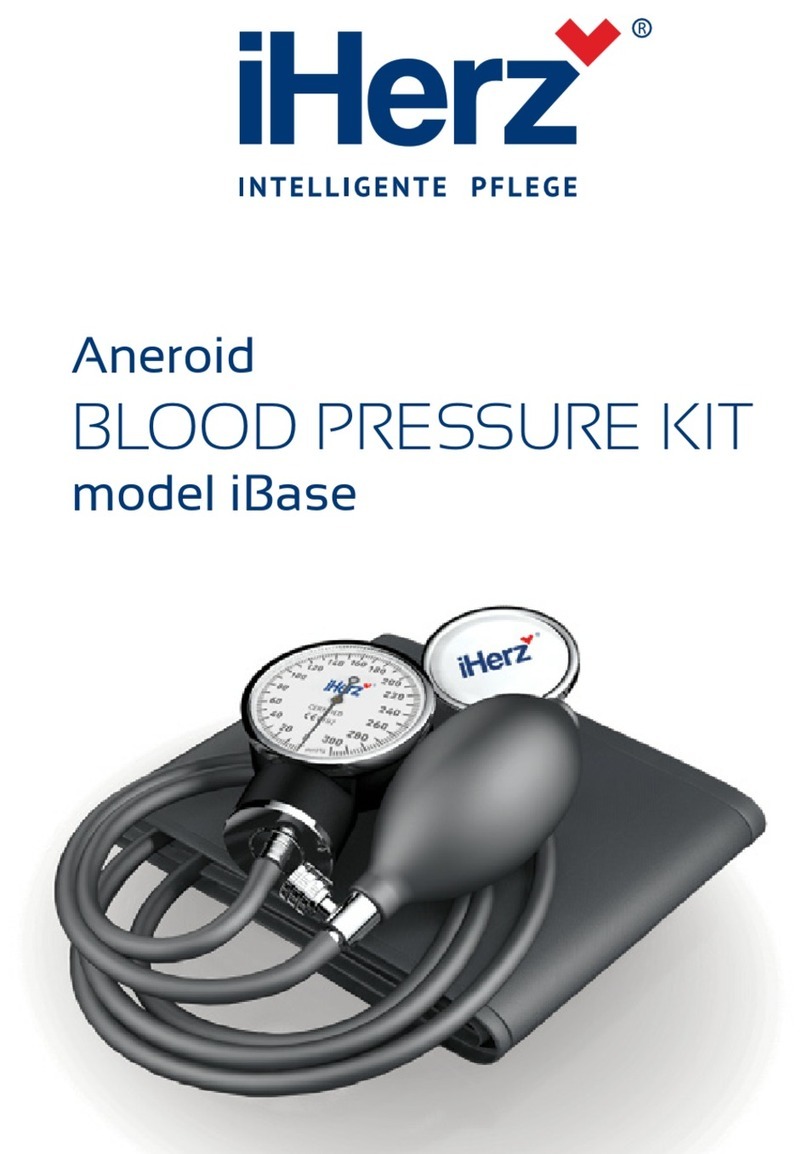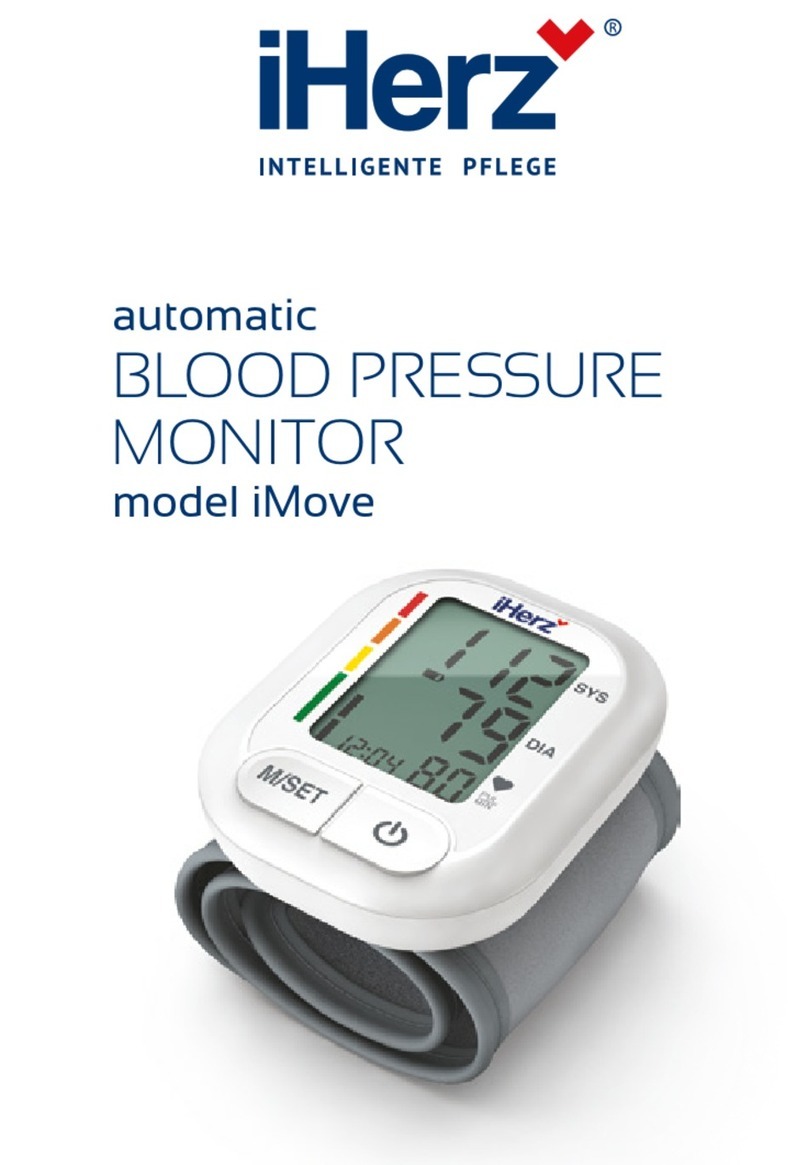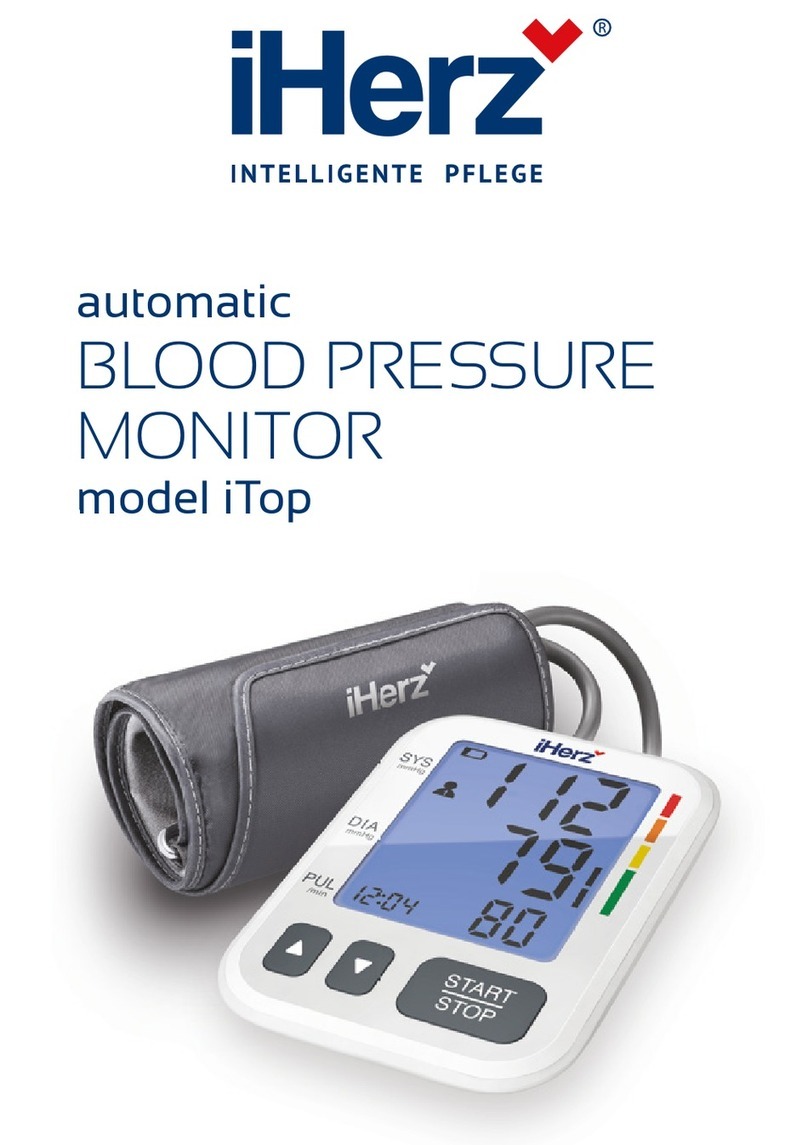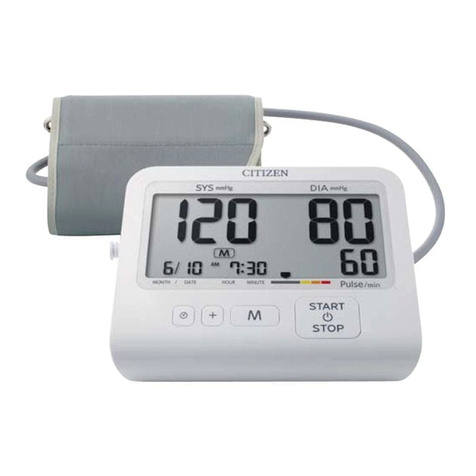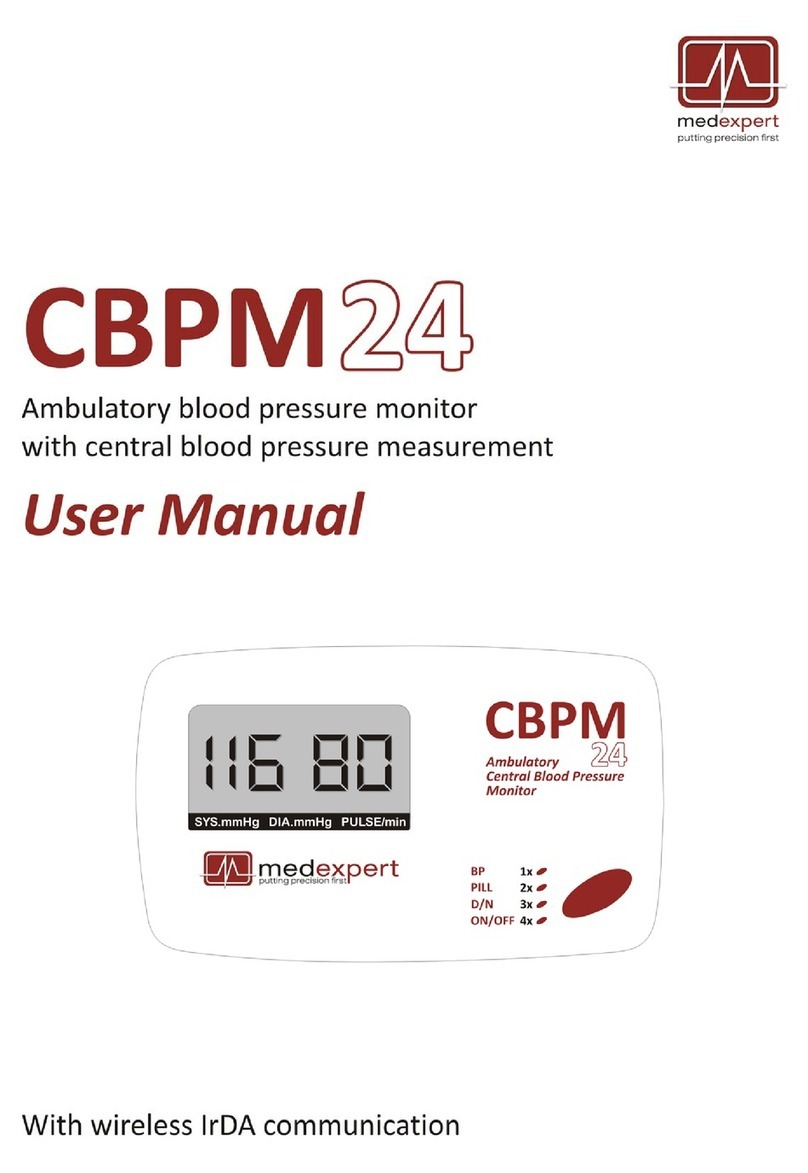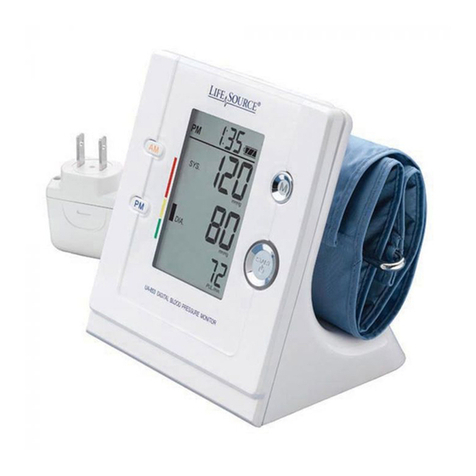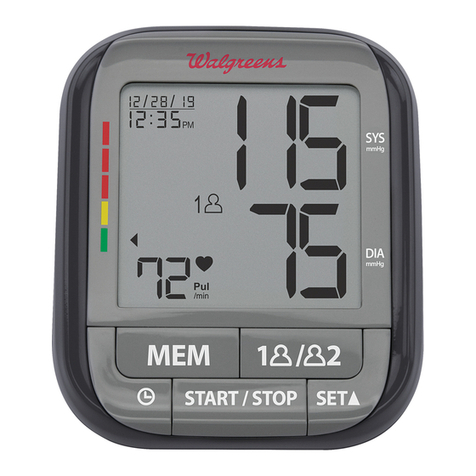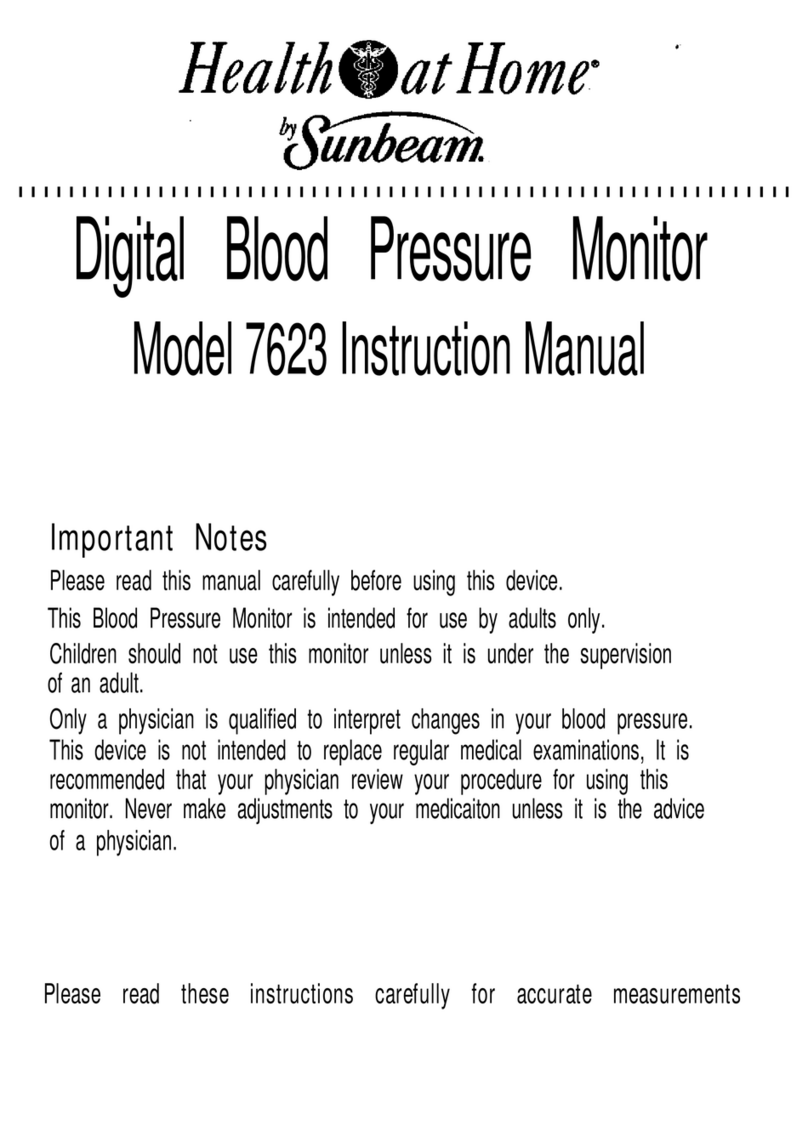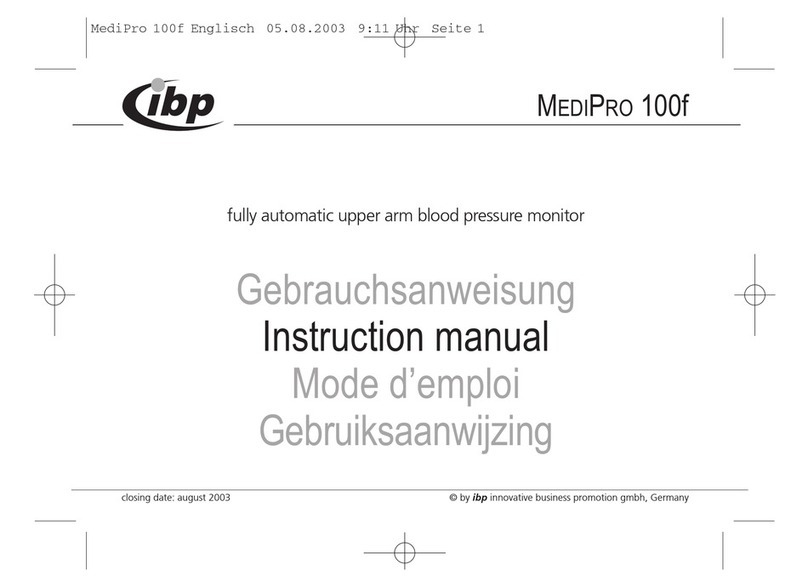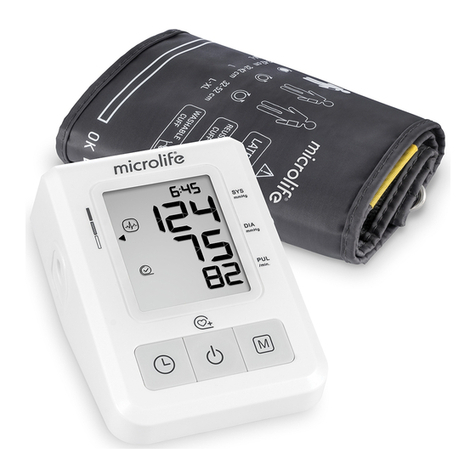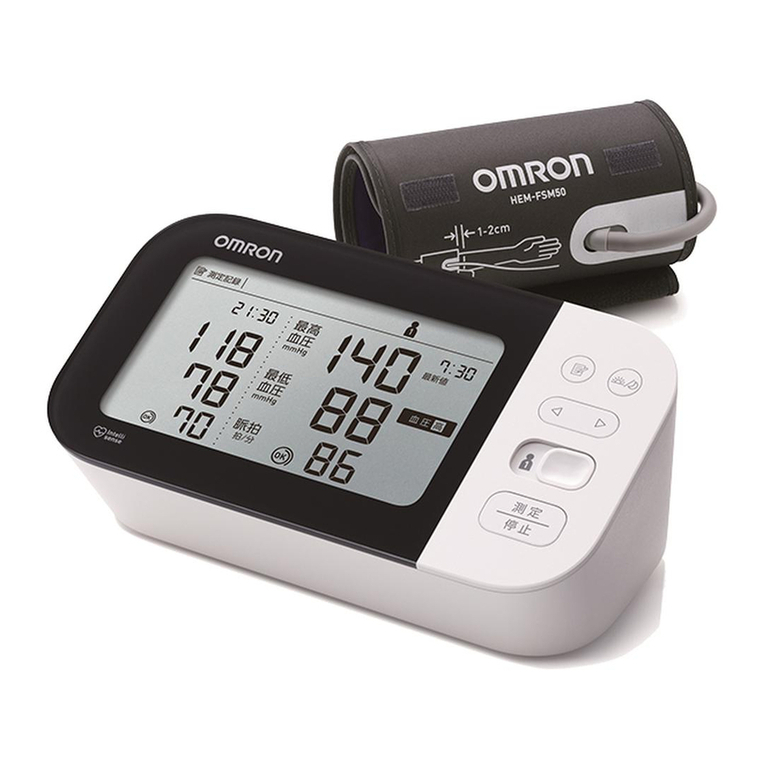iHerz iCare User manual

automatic
BLOOD PRESSURE
MONITOR
model iCare
MONITOR
m
m
o
o
d
d
e
e
l
l
i
i
C
C
a
a
r
r
e
e

2
DEAR TM iHerz®AUTOMATIC BLOOD
PRESSURE MONITOR OWNER
Thank you for choosing Automatic Blood Pressure Monitor TM iHerz®
model iCare. We are sure that having appraised worthily the high quality
and reliability of this device you will become a regular user of the products
of Italian Trademark TM iHerz®.
Before starting to use this device, please, study the user’s manual care-
fully. The user’s manual oers all information you need to measure your
blood pressure and pulse correctly. For all questions concerning the de-
vice, please, contact your local distributor or TM iHerz®service centre in
your country.
ATTENTION
This blood pressure monitor is designed to carry out self-control over
blood pressure but NOT to make self-diagnosis of hypertension/hypoten-
sion. Please, DO NOT diagnose by yourselves basing on the measure-
ment results obtained with the blood pressure monitor. Please, DO NOT
execute self-treatment of high/low blood pressure and DO NOT change
the methods prescribed without consulting your doctor.
Type BF applied part.
Read the instructions carefully before using this device.

3
EN
IMPORTANT INFORMATION ON BLOOD
PRESSURE AND ITS MEASUREMENT
What Is Blood Pressure?
Blood pressure is the pressure that your
blood extends to the vascular walls. Blood
pressure is necessary to provide for constant
blood ow inside the body. Thanks to it the
cells get oxygen that provides for their normal
functioning. The heart performs the function of
a «pump», sending blood to the blood vessels.
Each heart beat creates a certain level of the blood pressure.
There are 2 kinds of blood pressure: a systolic (upper) one, which cor-
responds to the heartbeat pushing blood into the arteriae; and a diastolic
(lower) one, which means the blood pressure between two heartbeats.
Blood pressure is subject to uctuations during the day even in healthy
people. The uctuations are inuenced by a number of factors - time of
day, person’s condition, physical or mental activity, environment, etc.
Day-Night Fluctuations of the Blood Pressure
An increase of blood pressure increases the burden onto the heart, aects
blood vessels making their walls thick and less elastic.
One of the features of the hypertension is its ability to remain unnoticed for
170
160
150
140
130
120
110
100
90
80
70
60
50
40
8.00 10.00 12.00 14.00 16.00 18.00 20.00 22.00 24.00 2.00 4.00 6.00 8.00
DIA blood pressure
SYS blood pressure
Time (hours)
mmHg

4
the patient at its early stages. That’s why the self control of the blood pres-
sure is so important. With the illness progressing, headaches and regular
dizziness appear, the sight declines, the functioning of vitals (encephalon,
heart, kidneys, blood vessels) breaks down. Without special treatment the
complications of hypertension might be kidney damages, breast-pang,
paralytic stroke, aphasia, dementia, heart attack and stroke.
Which Values are Normal?
The world standard as for the norms of the blood pressure is the
Classication* of the World Health Organization (WHO):
Category
Systolic
Blood Pressure
(mmHg)
Diastolic
Blood Pressure
(mmHg)
Blood pressure too low < 100 < 60
Blood pressure optimum 100 - 119 60 - 79
Blood pressure normal 120 - 129 80 - 84
Blood pressure slightly high 130 - 139 85 - 89
Blood pressure too high 140 - 159 90 - 99
Blood pressure far too high 160 - 179 100 - 109
Blood pressure dangerously high ≥ 180 ≥ 110
* Printed with curtailments.
• The diagnosis of hypertension requires from the patient to combine medi-
cal treatment prescribed by the doctor and mode of life correction.
• People with normal pressure and high normal pressure are recom-
mended to carry out self-control of their tension in order to timely take
measures to decrease the blood pressure level down to the optimal one
without using any medications.
• For people more than 50 years old high level of systolic blood pressure
(higher than 140 mmHg) is more crucial than diastolic pressure.
• Even with blood pressure being normal, people run the bigger risk of
hypertension development with advancing age.

5
EN
ATTENTION
If you have normal results of blood pressure measured under calm
conditions but your results are excessively high when measured under
the conditions of physical or mental exhaustion, this might be a sign of so
called brittle (that is unstable) hypertension. If you suspect that, please,
consult your doctor.
When measured correctly, if diastolic blood pressure is more than 120 mmHg,
it is necessary to call the doctor immediately.
ADVANTAGES OF AUTOMATIC BLOOD
PRESSURE MONITOR MODEL iCare
Blood Pressure Rate Indicator
Blood pressure rate indicator is located along left side of the display. The
classication corresponds to 6 ranges described in the table of the sec-
tion «Which values are normal?». After the measurement there appears
the dotted line in the left part of the display opposite the zone to which
the result of the measurement corresponds: green zone - optimal blood
pressure, yellow - elevated, orange - too high, red - dangerously high. This
function helps you to self-orient in the measurement results.
Irregular Heartbeat Detection Technology
An irregular heartbeat is detected when a heartbeat rhythm varies while
the unit is measuring the systolic and diastolic blood pressure.During each
measurement, the monitor records all the pulse intervals and calculate the
average ; if there are two or more pulse intervals ,the dierence between
each interval and the average is more than the average value of ±25% , or
there are four or more pulse intervals ,the dierence between each inter-
val and the average is more than the average value of ±15%,the irregular
heartbeat symbol appears on the display when the measurement results
are appear.

6
Multiple Users
2 users can make measurements and store data together. Memory allows
up to 60 results for each user enabling to display average results, which
include quite long period
of time. There is no need to write down and store the results on hard cop-
ies every time
after measurement.
GETTING READY FOR MEASUREMENT
Safety Precautions
* This device is intended for adult use in homes only.
* The device is not suitable for use on neonatal patients, pregnant
women,patients with
implanted, electronical devices, patients with pre-eclampsia, premature
ventricular beats, atrial brillation, peripheral, arterial disease and patients
undergoing intravascular therapy or arterio-venous shunt or people who
received a mastectomy. Please consult your doctor prior to using the unit
if you suer from illnesses.
* The device is not suitable for measuring the blood pressure of children.
Ask your doctor
before using it on older children.
* The device is not intended for patient transport outside a healthcare facility.
* The device is not intended for public use.
* This device is intended for no-invasive measuring and monitoring of arterial
blood pressure.
It is not intended for use on extremities other than the arm or for functions
other than
obtaining a blood pressure measurement.
* Do not confuse self-monitoring with self-diagnosis. This unit allows you to moni-
tor your blood pressure.Do not begin or end medical treatment without asking a
physician for treatment advice.
* If you are taking medication,consult your physician to determine the most
appropriate time to measure your blood pressure. Never change a pre-

7
EN
scribed medication without consulting your physician.
* Do not take any therapeutic measures on the basis of a self measure-
ment. Never alter the dose of a medicine prescribed by a doctor. Consult
your doctor if you have any question about your blood pressure.
* When the device was used to measure patients who have common ar-
rhythmias such as atrial or ventricular premature beats or atrial brillation,
the best result may occur with
deviation. Please consult your physician about the result.
* Don’t kink the connection tube during use, otherwise, the cu pressure
may continuously increase which can prevent blood ow and result in
harmful injury to the PATIENT.
* When using this device, please pay attention to the following situation
which may interrupt blood ow and inuence blood circulation of the pa-
tient, thus cause harmful injury to the patient: connection tubing kinking
too frequent and consecutive multiple measurements; the application of
the cu and its pressurization on any arm where intravascular access or
therapy, or an arterio-venous (A-V) shunt, is present; inating the cu on
the side of a mastectomy.
* Warning: Do not apply the cu over a wound;otherwise it can cause
further injury.
*Do not inate the cu on the same limb which other monitoring ME
equipment is applied around simultaneously, because this could cause
temporary loss of function of those simultaneously-used monitoring ME
equipment.
*On the rare occasion of a fault causing the cu to remain fully inated
during measurement, open the cu immediately. Prolonged high pressure
(cu pressure > 300mmHg or constant pressure > 15mmHg for more than
3 minutes) applied to the arm may lead to an ecchymosis.
*Please check that operation of the device does not result in prolonged
impairment of patient blood circulation.
* When measurement, please avoid compression or restriction of the con-
nection tubing.
* The device cannot be used with HF surgical equipment at the same time.
* The ACCOMPANYING DOCUMENT shall disclose that the SPHYG-
MOMANOMETER
was clinically investigated according to the requirements of ISO 81060-
2:2013.

8
* To verify the calibration of the AUTOMATED SPHYGMOMANOMETER,
please contact the manufacturer.
* This device is contraindicated for any female who may be suspected of,
or is pregnant. Besides providing inaccurate readings, the eects of this
device on the fetus are unknown.
* Too frequent and consecutive measurements could cause disturbances
in blood
circulation and injuries.
* This unit is not suitable for continuous monitoring during medical emer-
gencies or operations. Otherwise, the patient’s arm and ngers will be-
come anaesthetic, swollen and even purple due to a lack of blood.
* When not in use, store the device in a dry room and protect it against ex-
treme moisture, heat, lint, dust and direct sunlight. Never place any heavy
objects on the storage case.
* This device may be used only for the purpose described in this booklet.
The manufacturer cannot be held liable for damage caused by incorrect
application.
*This device comprises sensitive components and must be treated with
caution. Observe the storage and operating conditions described in this
booklet.
* The equipment is not AP/APG equipment and not suitable for use in
the presence of a ammable anesthetic mixture with air of with oxygen
or nitrous oxide.
* Warning: No servicing/maintenance while the ME equipment is in use.
* The patient is an intended operator.
* The patient can measure data and change batteries under normal cir-
cumstances and
maintain the device and its accessories according to the user manual.
* To avoid measurement errors, please avoid the condition of strong elec-
tromagnetic
eld radiated interference signal or electrical fast transient/burst signal.
* The blood pressure monitor and the cu are suitable for use within
the patient environment. If you are allergic to polyester, nylon or plastic,
please don’t use this device.
* During use, the patient will be in contact with the cu. The materials of
the cu have been tested and found to comply with requirements of ISO
10993-5:2009 and ISO 10993-10:2010. It will not cause any potential sen-

9
EN
sization or irritation reaction.
* If you experience discomfort during a measurement, such as pain in the
arm or other complaints, press the START/STOP button to release the air
immediately from the cu. Loosen the cu and remove it from your arm.
* If the cu pressure reaches 40 kPa (300 mmHg), the unit will automati-
cally deate. Should the cu not deate when pressures reaches 40 kPa
(300 mmHg), detach the cu from the arm and press the START/STOP
button to stop ination.
* Before use, make sure the device functions safely and is in proper work-
ing condition. Check the device, do not use the device if it is damaged in
any way. The continuous use of a damaged unit may cause injury, im-
proper results, or serious danger.
* Do not wash the cu in a washing machine or dishwasher!
* The service life of the cu may vary by the frequency of washing, skin
condition, and storage state. The typical service life is 10000 times.
* It is recommended that the performance should be checked every 2
years and after
maintenance and repair, by retesting at least the requirements in limits of
the error of the cu pressure indication and air leakage (testing at least at
50mmHg and 200mmHg).
* Please dispose of ACCESSORIES, detachable parts, and the ME
EQUIPMENT according to the local guidelines.
* Manufacturer will make available on request circuit diagrams, compo-
nent part lists,
descriptions, calibration instructions,etc., to assist to service personnel in
parts repair.
* The operator shall not touch output of batteries and the patient simul-
taneously.
* Cleaning :Dust environment may aect the performance of the unit. Please
use the soft cloth to clean the whole unit before and after use. Don’t use any
abrasive or volatile cleaners.
* The device doesn’t need to be calibrated within two years of reliable
service.
* If you have any problems with this device, such as setting up, main-
taining or using, please contact the SERVICE PERSONNEL of Transtek.
Don’t open or repair the device by yourself in the event of malfunctions.
The device must only be serviced, repaired and opened by individuals at

10
authorized sales/service centers.
* Keep the unit out of reach of infants, young children or pets to avoid inha-
lation or swallowing of small parts. It is dangerous or even fatal.
* Be careful to strangulation due to cables and hoses, particularly due to
excessive length.
* At least 30 min required for ME equipment to warm from the minimum
storage temperature between uses until it is ready for intended use. At
least 30 min required for ME equipment to cool from the maximum storage
temperature between uses until it is ready for intended use.
* This equipment needs to be installed and put into service in accordance
with the information provided in the ACCOMPANYING DOCUMENTS;
* Wireless communications equipment such as wireless home network de-
vices, mobile phones, cordless telephones and their base stations, walkie-
talkies can aect this equipment and should be kept at least a distance d
away from the equipment. The distance d is caculated by the MANUFAC-
TURER from the 80MHz to 5.8 GHz column of Table 4 and Table 9 of IEC
60601-1-2:2014, as appropriate.
* Please use ACCESSORIES and detachable partes specied/ authorised
by MANUFACTURE. Otherwise, it may cause damage to the unit or dan-
ger to the user/patients.
* There is no luer lock connectors are used in the construction of tub-
ing, there is a possibility that they might be inadvertently connected to
intravascular uid systems, allowing air to be pumped into a blood vessel.
* Please use the device under the environment which was provided in the
user manual. Otherwise, the performance and lifetime of the device will be
impacted and reduced.
KEEP THIS MANUAL DURING THE WHOLE LIFETIME OF THE DEVICE
Components of Your Blood Pressure Monitor Kit
The blood pressure monitor kit includes Automatic Blood Pressure
Monitor model iCare, 22 - 32 cm cu, 4 batteries 1,5 V (AAA), user’s
manual, warranty card, kit box.

11
EN
Description of the Blood Pressure Monitor
1. AIR CONNECTOR PLUG
2. LCD DISPLAY
3. MEM BUTTON
4. SET BUTTON
5. START/STOP BUTTON
6. CUFF
7. AIR HOSE
8. BATTERY COMPARTMENT
Installing and Replacing the Batteries
• Open the battery cover.
• Install the batteries as indicated in the battery
compartment.
(Always select the authorized / specied
battery: Four AAA-size batteries).
• Replace the battery cover.
Replace the batteries whenever the below happen
• The shows
• The display is dim
• The display does not light up
6
7
1
2
3
5
4
8

12
• Do not use new and used batteries together.
• Do not use dierent types of batteries together.
• Do not dispose the batteries in re. Batteries may explode or leak.
• Remove batteries if the device is not likely to be used for some time.
• Worn batteries are harmful to the environment. Do not dispose with daily
garbage.
• Remove the old batteries from the device following your local recycling
guidelines.
LCD display signal
SYMBOL DESCRIPTION EXPLANATION
Systolic blood
pressure
High blood pressure
Diastolic blood
pressure
Low blood pressure
Pulse display Pulse in beats per minute
Deation symbol The cu is deating.
Memory Indicate it is in the memory mode
and which group of memory it is.
kPa Measurement Unit of the blood
pressure

13
EN
mmHg Measurement Unit of the blood
pressure
Low battery Batteries are low and need to be
replaced
Irregular heart-
beat
Blood pressure monitor is detect-
ing an irregular heartbeat during
measurement.
Blood pressure
level indicator
Indicate the blood pressure level
Current Time Year/Month/Day, Hour/Minute
Heartbeat Blood pressure monitor is detect-
ing a heartbeat during measure-
ment.
User 1, User 2 Start measurement for User 1,
User 2
Setting the Date and Time
It is important to set the clock before using your blood pressure monitor,
so that a time stamp can be assigned to each record that is stored in the
memory. (The setting range of the year :2014—2054 time format:12 H/24H)
1. When the monitor is o, hold pressing “SET” for 3 seconds to enter the
mode for year setting. Or when the monitor is o, press “SET” button
shortly, it will display the time. Then hold pressing “SET” button to enter
the mode for year setting.
2. Press the “MEM” to change the [YEAR]. Each press will increase the
numeral by one in a cycling manner.
3. When you get the right year, press “SET” to set down and turn to next
step.Repeat steps 2 and 3 to set the [MONTH] and [DAY].

14
4. Repeat steps 2 and 3 to conrm the time format [12H] and [24h].
5. Repeat steps 2 and 3 to set the [HOUR] and [MINUTE].
6. Repeat steps 2 and 3 to set the [UNIT].
7. After the unit is set,the LCD will display “donE”rst,then display all the
settings you have done and then it will turn o.
MEASUREMENT PROCEDURE
ATTENTION
• Find time to relax by sitting in a quiet atmosphere for some time before
measurement.
• Be seated with your feet at on the oor, and don’t cross your legs.
Place palm upside in front of you on a at surface such as desk or
table. The middle of the cu should be at the level of the right atrium
of the heart.
• Eorts by the patient to support the arm can increase the blood pres-
sure. Make sure you are in a comfortable, relaxed position and do not
activate any muscles in the arm during measurement.
• Always measure on the same arm (normally left).
• Remove any garment that ts closely to your upper arm. Do not roll the
sleeve since it can squeeze your hand and this can lead to false results.
• Use only clinically approved original cu.
• If you want to follow the results of your blood pressure measurements,
always perform measurements at the same time of day, since blood
pressure changes during the course of the day.
• Measurements should be done after a 5 minute rest to ensure accuracy.

15
EN
Fitting the Cu
Select a pressure cu size that corresponds to the circumference of your
shoulder (measured with a tight t in the middle of the shoulder). The size
M (22-32 cm) is a size tting the majority of people.
1. Remove all jewelry, such as watches and
bracelets from your left arm.Note: If your doctor
has diagnosed you with poor circulation in your left
arm, use your right arm.
2. Roll or push up your sleeve to expose the skin.
Make sure your sleeve is not too tight.
3. Hold your arm with your palm facing up and tie
the cu on your upper arm, then position the tube
o-center toward the inner side of arm in line with
the little nger. Or position the artery mark over
the main artery (on the inside of your arm).
Note: Locate the main artery by pressing with 2
ngers approximately 2 cm above the bend of your
elbow on the inside of your left arm. Identify where
the pulse can be felt the strongest. This is your
main artery.
4. The cu should be snug but not too tight. You
should be able to insert one nger between the
cu and your arm.
5. Sit comfortably with your tested arm resting on a at surface. Place
your elbow on a table so that the cu is at the same level as your heart.
Turn your palm upwards. Sit upright in a chair, and take 5-6 deep breaths.
6. Helpful tips for Patients, especially for Patients with Hypertension:
• Rest for 5 minutes before rst measuring.
• Wait at least 3 minutes between measurements.
• This allows your blood circulation to recover.
• Take the measurement in a silent room.
• The patient must relax as much as possible and do not move and talk
during the measurement procedure.
• The cu should maintain at the same level as the right atrium of the heart.
• Please sit comfortably. Do not cross your legs and keep your feet at
on the ground.
2-3 cm
Arm cu

16
• Keep your back against the backrest of the chair.
• For a meaningful comparison, try to measure under similar conditions.
For example, take daily measurements at approximately the same time,
on the same arm, or as directed by a physician.
Measuring Procedure
When the monitor is o, press the “START/STOP” to turn on the monitor,
and it will nish the whole measurement .(Take User 1 for example)
Press the “START/STOP” to power o, otherwise it will
turn o within 1 minute.
MEMORY FUNCTION
Reading Measurement Results
1. When the monitor is o, please press the
“MEM” to show the average value of the latest
three records.If the records are less than three
groups,it will display the latest record rst.
2. Press the “MEM” or “SET” to get the record you
want.
LCD display Adjust the zero Inating and
measuring
Display and
save the results

17
EN
The date and time of
the record will be shown
alternately.
CAUTION
The most recent record (1) is shown rst. Each new measurement is
assigned to the rst (1) record. All other records are pushed back one digit
(e.g., 2 becomes 3, and so on), and the last record (60) is dropped
Delete Memories
If you did not get the correct measurement, you can delete all results
by following steps below.
1. Hold pressing “MEM+SET” for 3 seconds when the monitor is in the
memory recall mode ,the ash display will show.
2. Press “SET” to conrm deleting and the monitor will
turn o.
3. If you don’t want to delete the records, press “START/
STOP” to escape.
4. If there is no record, the right display will show.
The current No. is No 2.T he corresponding
time is P.M. 10:08.
The corresponding
date is January 1st.

18
ERROR MESSAGES/ TROUBLESHOOTING
This section includes a list of error messages and frequently asked ques-
tions for problems you may encounter with your blood pressure monitor.
If the products not operating as you think it should, check here before
arranging for servicing.
PROBLEM SYMPTOM CHECK THIS REMEDY
No power
Display will not
light up.
Batteries are ex-
hausted.
Replace with new
batteries
Batteries are inserted
incorrectly.
Insert the batteries
correctly
Low batteries Display is dim
or show
Batteries are low. Replace with new
batteries
Error message
E 1 shows The cu is too tight
or too loose.
Readjust the cu ,not
too loose or too tight
and then measure
again.
E 3 shows The pressure of the
cu is excess.
Relax for a moment
and
then measure again.
E 10 or
E 11 shows
The monitor detected
motion while measur-
ing.
Movement can aect
the measurement.
Relax for a moment
and then measure
again.
E 20 shows The measurement
processdoes not
detect the pulse
signal.
Loosen the clothing on
the wrist and then
measure again.
E 21 shows Measure incorrectly. Relax for a moment
and then measure
again.
EExx,shows on
the display.
A calibration error
occurred.
Retake the measure-
ment. If the problem
persists, contact the
retailer or our customer
service department
for further assistance.
Refer to the warranty
for contact information
and return

19
EN
Warning
message
“out ” shows Out of measurement
range
Relax for a moment.
Refasten the cu
and then measure
again. If the problem
persists, contact your
physician.
The functionality of this device may be disturbed by the use of strong
electromagnetic elds such as mobile phones or radio stations at close
range, so we recommend that these devices be kept at least 1 m away.
In cases where this is inevitable, please make sure that the device is
working properly before use. If you are suering from a heartbeat disorder
(arrhythmia), evaluation of measurement results of the device can be
given only after consultation with a physician.
CARE AND MAINTENANCE
In order to get the best performance, please follow the instructions below.
Put in a dry place and avoid the sun-
shine
Avoid touching water, clean it with a dry
cloth in case.
Avoid intense shaking and collisions
Avoid dusty and unstable temperature
environment

20
Using wet cloths to remove dirt
Do not attempt to clean the reusable
cu with water and never immerse the
cu in water.
Disinfection: If required (for example, in a hospital setting), disinfection of
the pressure cu twice per week is recommended.
Disinfect the interior of the pressure cu (the surfaces that come into con-
tact with the patient’s skin) with the use of a soft cloth soaked in ethyl
alcohol (75-90%) and wait for the pressure cu to dry up.
Cleaning of the pressure cu after 200 uses is recommended.
Periodic calibration of device: the accuracy of measurement instru-
ments must be veried from time to time. For this reason, verication of
the indication of statistical pressure periodically (once a year) and after
technical maintenance and repair is recommended. More information can
be obtained from the service center.
SYMBOL INFORMATION
SYMBOL REFERENT
Consult instruction for use
Manufacturer
Manufacturing date
Table of contents
Other iHerz Blood Pressure Monitor manuals
